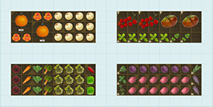Basics
- Ease of Growing
- Moderate
- Grown as
- Annual
- Days to Maturity
- 50-70 (Spring/Summer)
- Growing Habit
- -
- Hardiness
- Half Hardy
Borage is half hardy, and can resist light frost.
- Crops
- Spring
- Growing Season
- Short, Long
- Cultivar Type
- -
- Growing Conditions
- Cool, Warm
Borage thrives in cool climates and likes full sun, although it can tolerate partial shade. In hot climates, partial shade is best. The plant is very adaptable to a variety of environmental conditions and will grow very easily.
- Outdoor Growing Temp
- 55°F - 80°F
- Min Outdoor Soil Temp
- 60°F
Borage can be sowed outdoors once the soil temperature reaches roughly 60˚ F, but germinates best around 70˚ F.
- Start Indoors
- No
- Start Outdoors
- Yes
- Light
- Sun: min. 6 hours daily (Cool, Warm)
Plant borage in a sunny part of the garden.
- Water
- Moderate
Borage seedlings will require regular watering, but once established, the plant is fairly drought tolerant.
- Feeder
- Light
Borage will grow fine in poor soil but will grow taller in soil that is rich in nutrients and organic matter. Soil too rich in nitrogen may cause the plant to bloom less.
- Suitability
- Tolerates light frost, Partial shade
- Small Gardens?
- Yes
- Containers?
- Yes
Borage will grow well in containers that are at least 12" deep.
- Attracts beneficial insects?
- Yes
- Color
- Blue
- Fruit Size
- - "
- Plant Height
- 24.0 - 30.0"
- Plant Diameter
- 12.0 - 18.0"
- Good Companions
- Strawberry, Squash, Summer, Squash, Winter, Gourds, Pumpkin, Cucumber, Tomato
- Bad Companions
- -
- Hardiness Zone
- 5-11
- Disease Resistance
- Taste Profile
Mild, cucumber-like taste.
- Rotation Group
- Flowers

